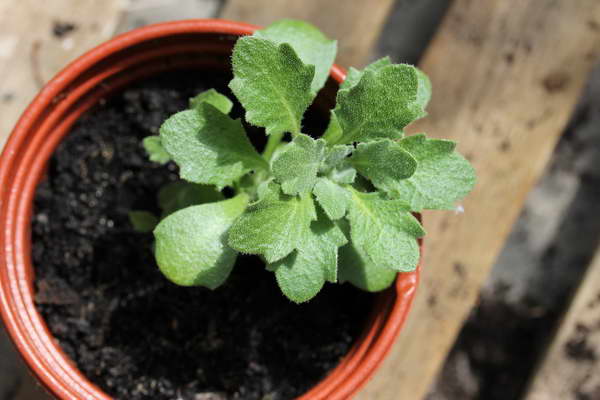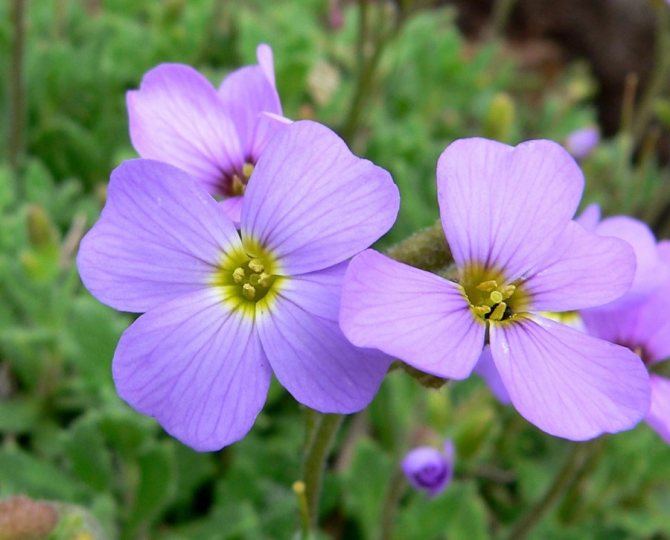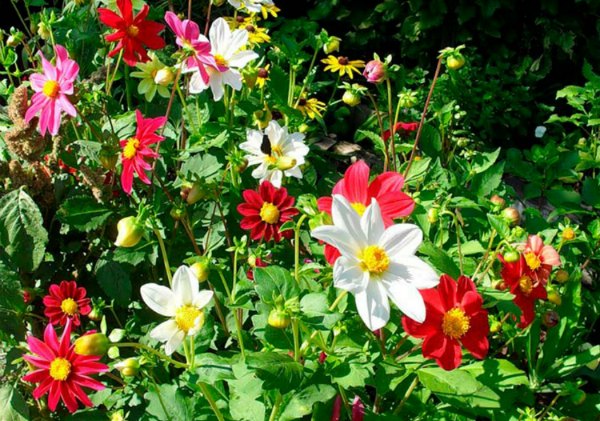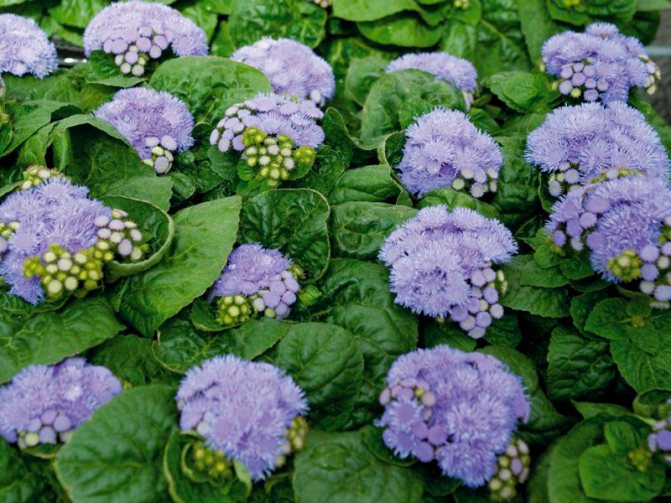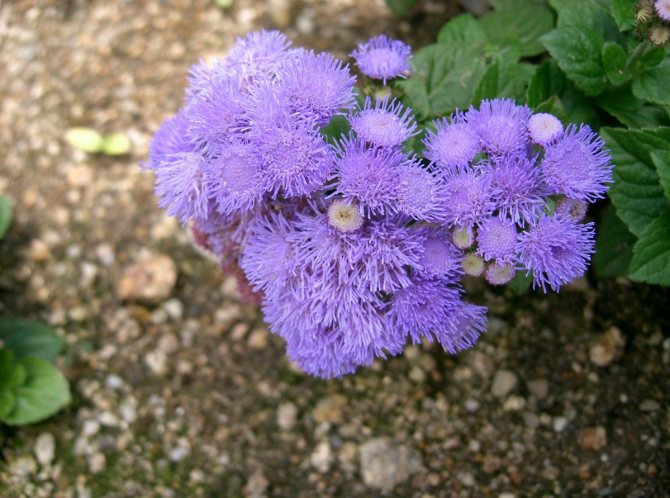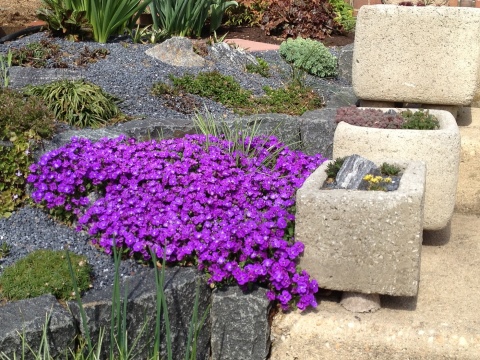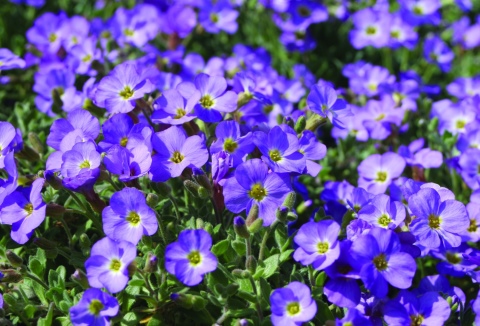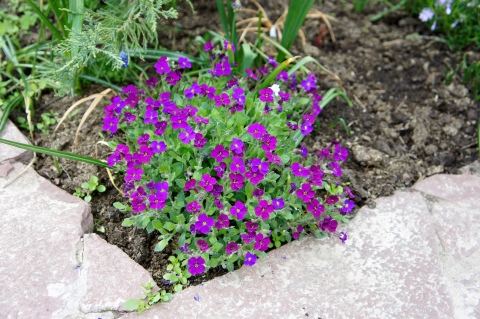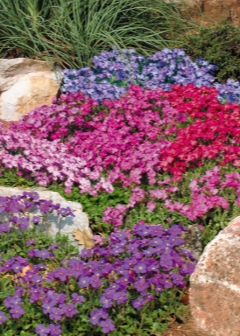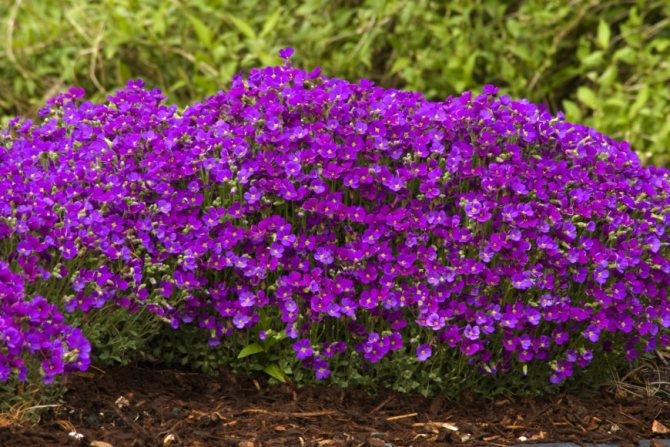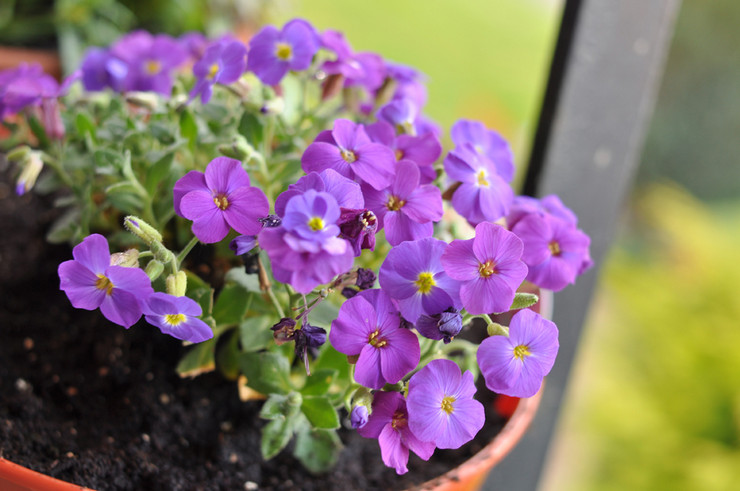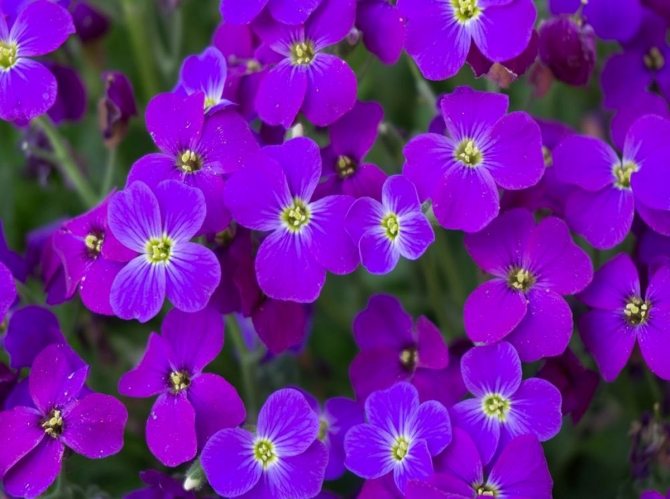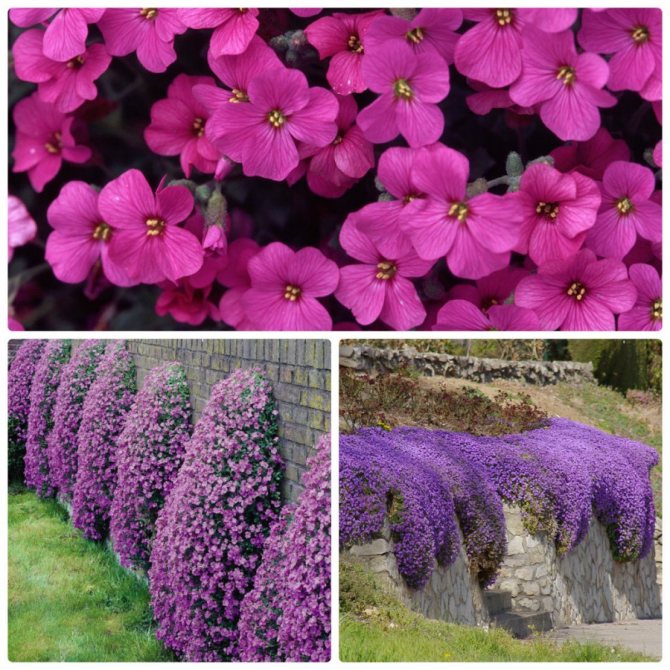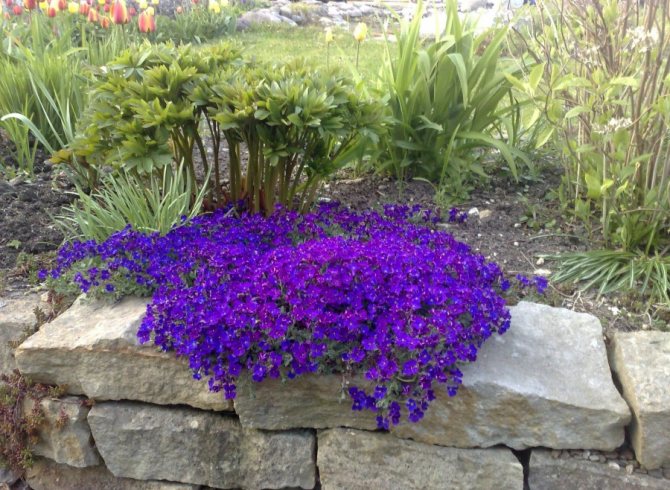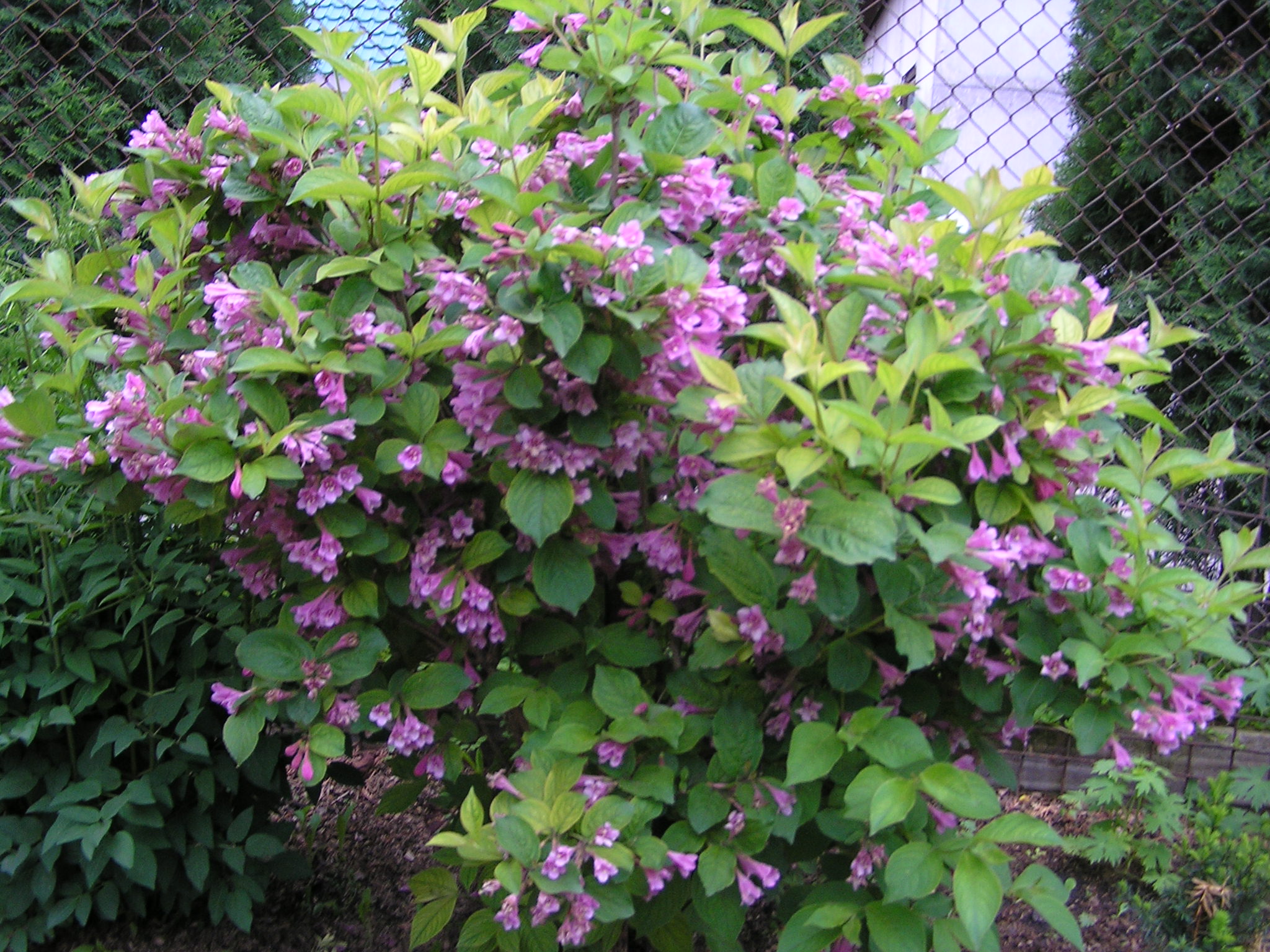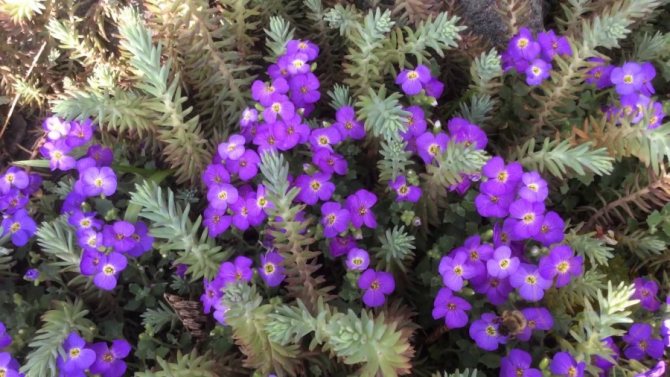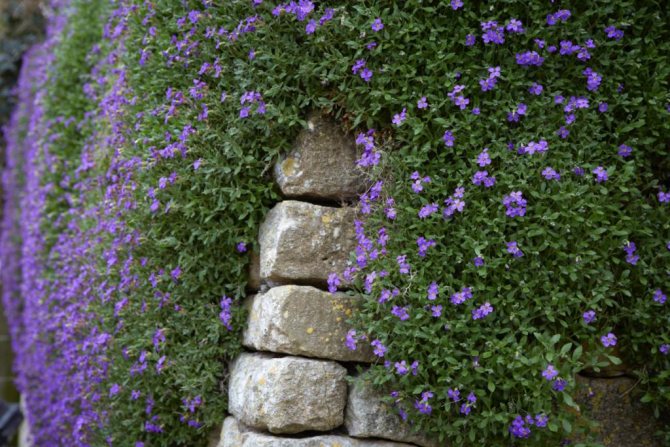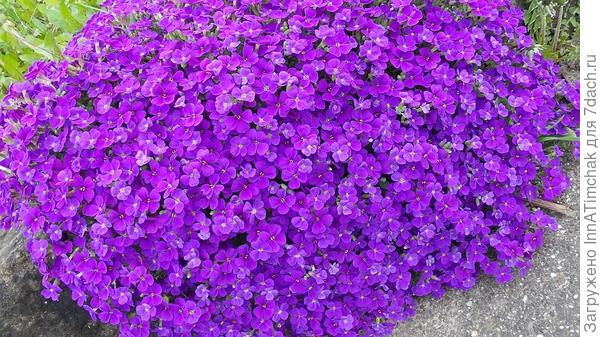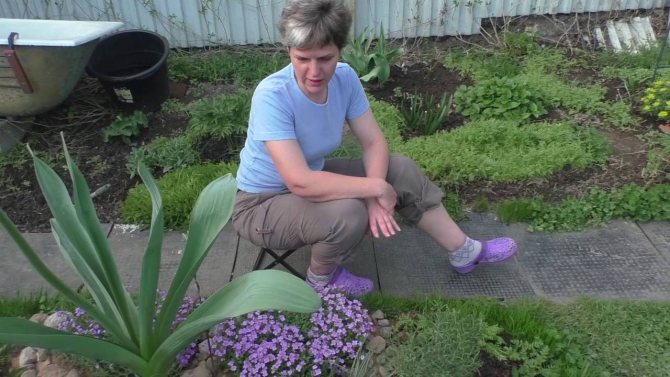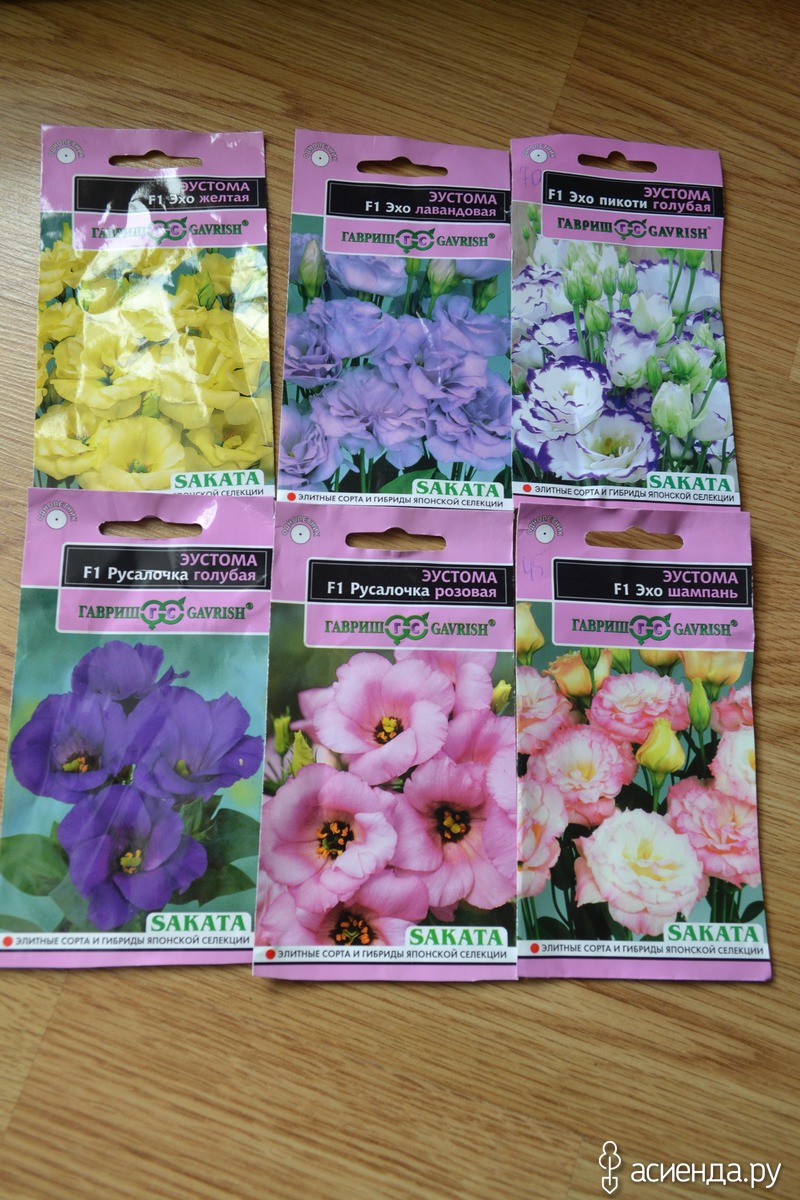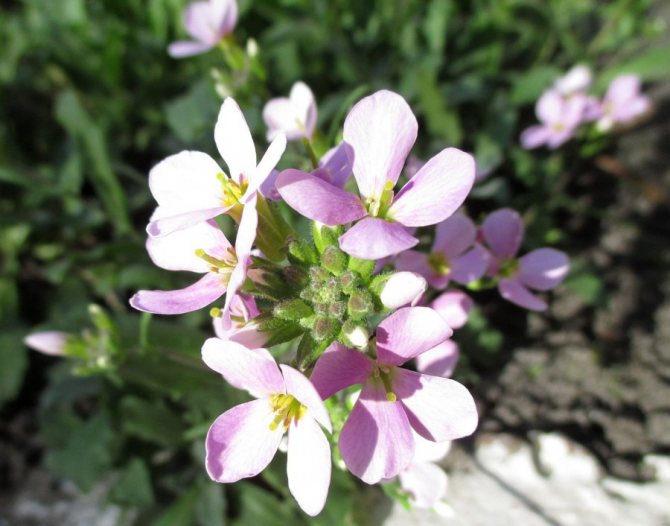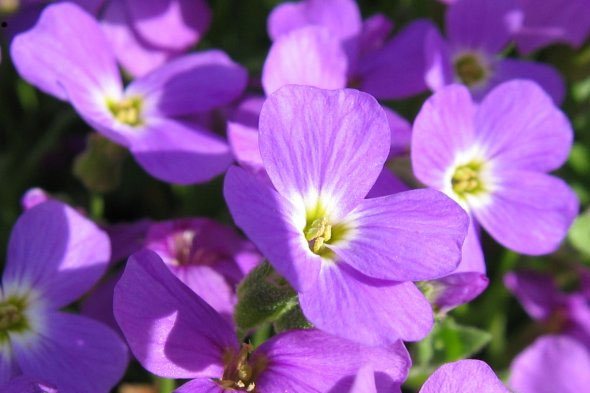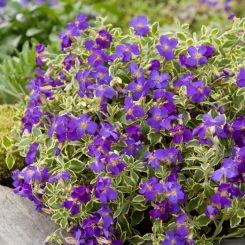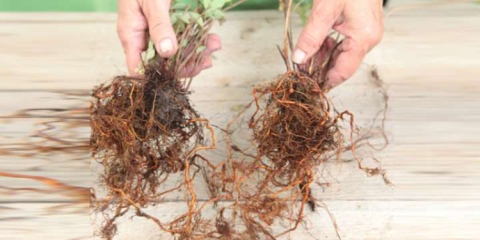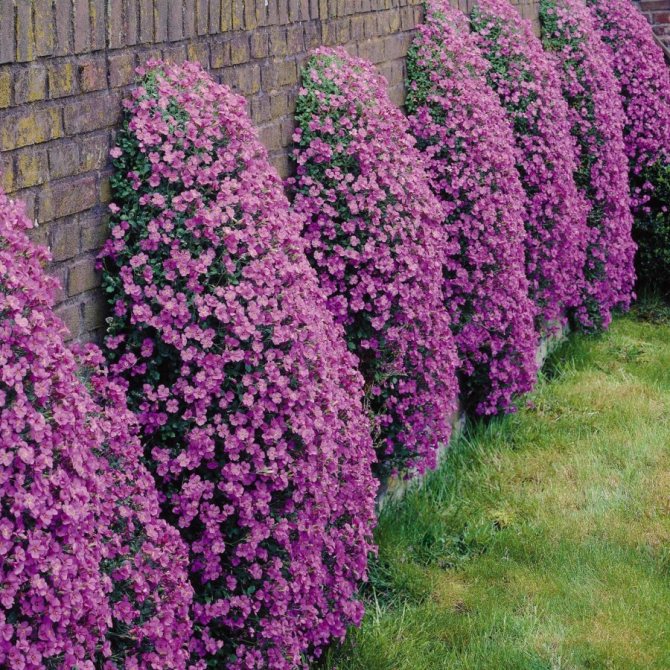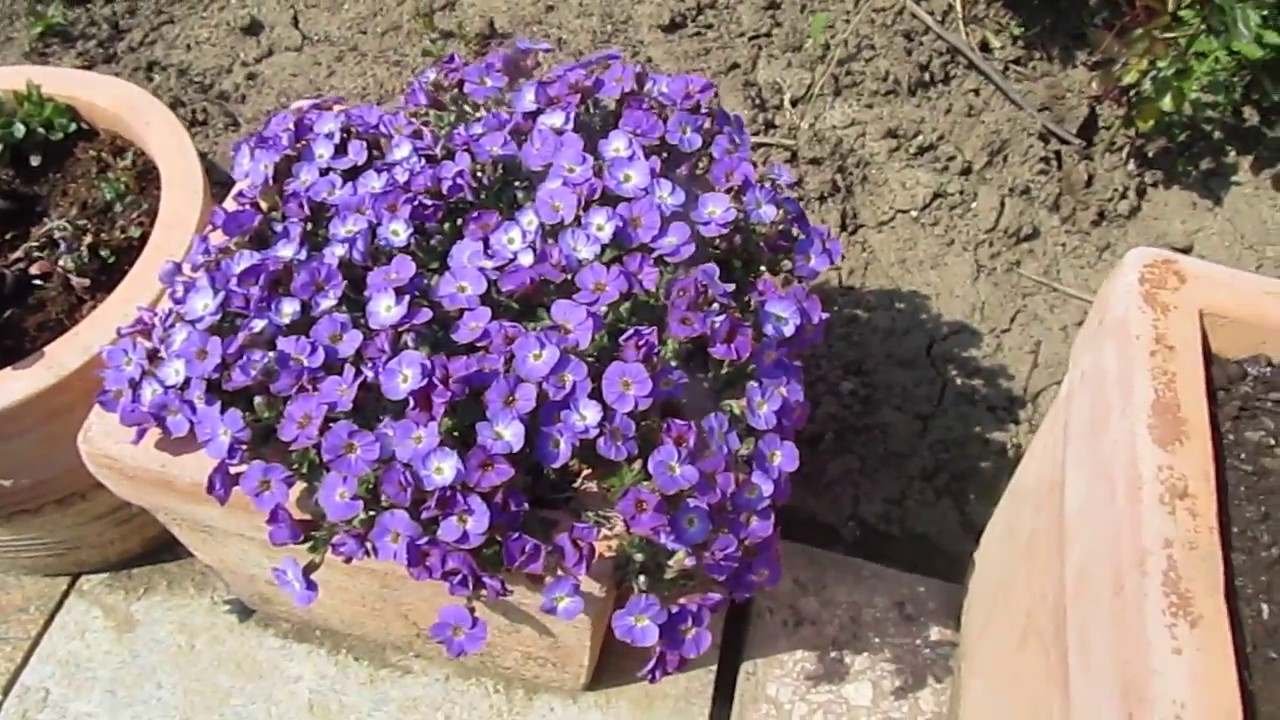Types and varieties of obriety with photos and names
Types and varieties of obriety differ in the structure of the plant, the colors of the corollas.
Aubrieta deltoidea
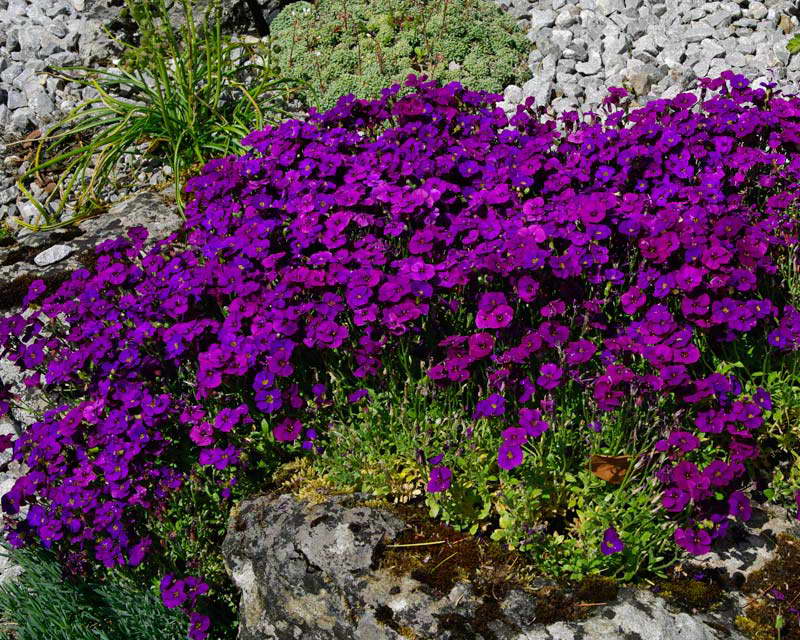
Aubrieta deltoidea purple Aubrieta deltoidea cultivar Kitte Purple photo
People call it a lilac bush. The height of the bush is 15 cm. The leaf plates are deltoid, there are 1-2 teeth on each edge, a shade of gray-green. Loose racemose inflorescences consist of small flowers (corolla diameter about 1 cm) lilac or purplish blue. Cultivated since 1710. Bougainvillea variety: plant height is 20 cm, flowers are light purple with an orange eye.
Aubrieta cultural or Aubrieta hybrid Aubrieta x cultorum

A group of perennial herbaceous plants with a height of no more than 20 cm, in a temperate climate, successfully winter under a snow cover. Leaves are oblong, serrated. Flowers can be simple, double, semi-double. Some varieties can be grown as a pot crop, some are suitable for cutting.
Consider the most popular varieties of cultural obriety:
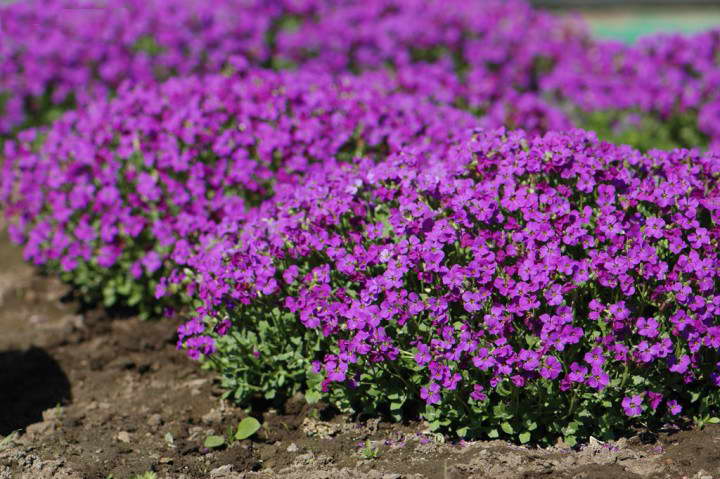
Cascading - leaves of a gray-green hue; inflorescences of a red or blue shade are decorated with a yellow eye.
Fascinating Morocco - has the largest flowers (about 1.5 cm in diameter), colors from blue to various shades of red and pink;
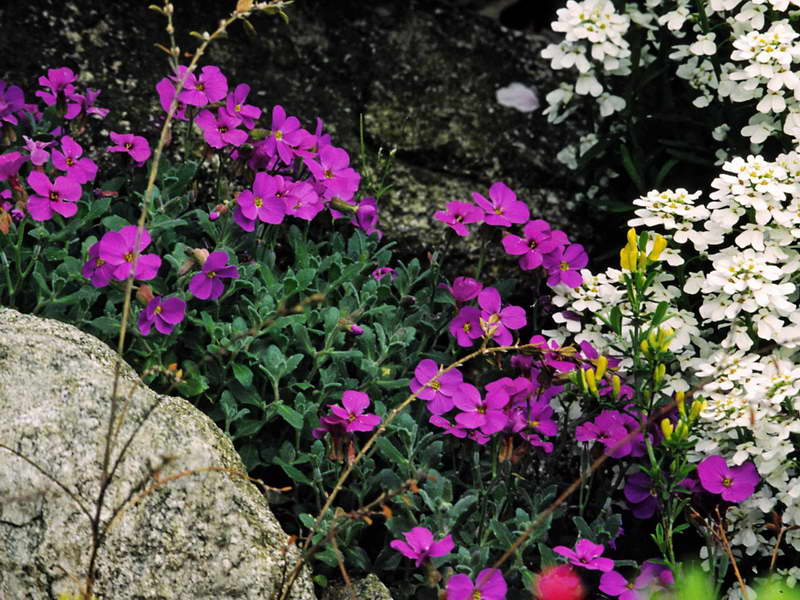
Aubrieta aubretia Dr. Mules Aubrieta x cultorum ‘Dr. Mules' photo
Dr. Mules is a bush about 15 cm high with blue-violet inflorescences;

Borshiz White is a rare variety with snow-white inflorescences.
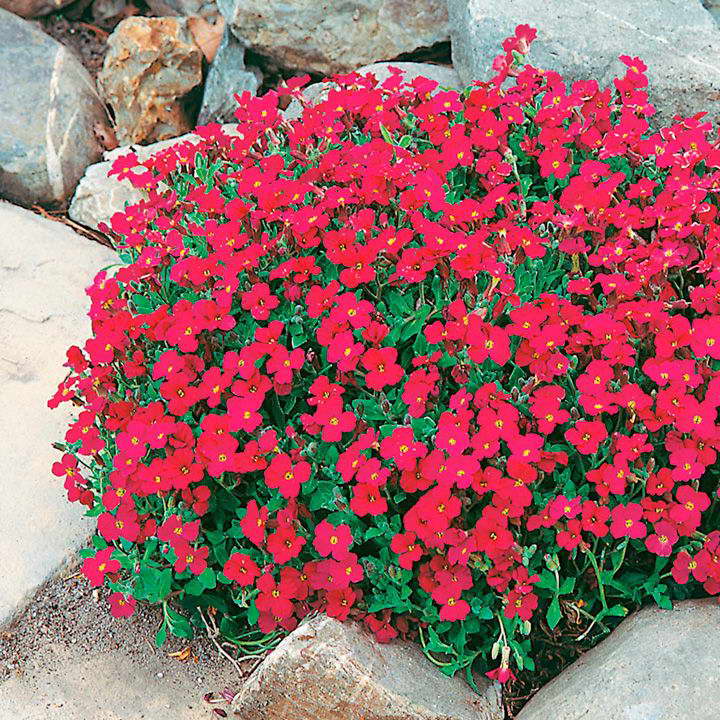
Cote d'Azur - aqua-colored inflorescences adorn the garden throughout June-July, re-flowering starts in September and lasts until the very frost;

Aubretia Aubrieta 'Axcent Violet With Eye' photo
A giant waterfall - bushes 15 cm high with flowers of purple, pink, red, lilac shades. It is a mixture of varieties - purple, pink, red, purple ... This winter-hardy perennial up to 15 cm in height reveals flowers up to 1 cm in diameter.
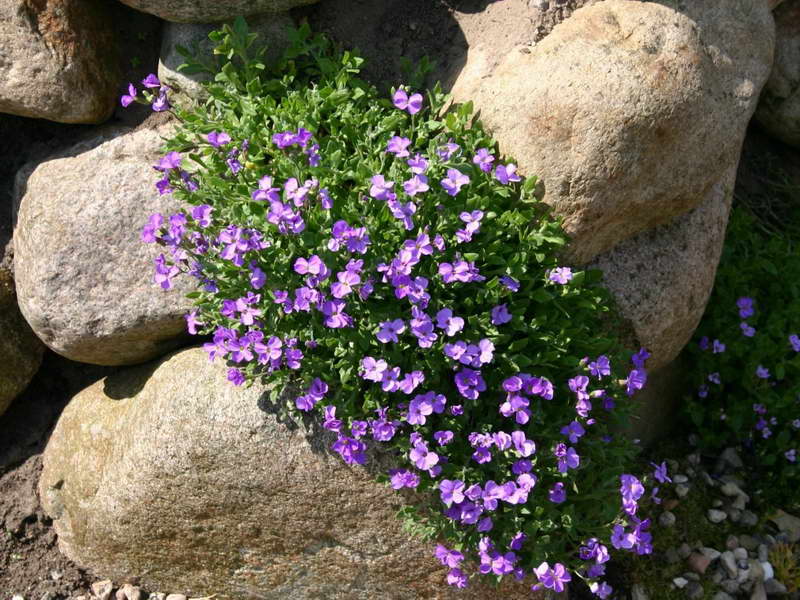
Aubrieta Aubrieta ‘Hamburger Stadtpark’ photo
Also pay attention to the varieties Gloriosa, Don, Carnival, Queen, Blue King, Wanda, Triumfat, Royal Keskade
Shaving care in the garden
Adult aubretia does not tolerate over-watering. It is necessary to irrigate the flower bed only during prolonged drought. If you increase the frequency of watering, the bush can get sick with a fungus or begin to produce a large amount of green mass, which will affect the abundance of flowering.
After precipitation or sprinkling, the soil is loosened, along the way weeds are blasted out. The culture loves sand mulching. You need to add it 2-3 times per season to a height of 3-5 cm. Top dressing based on phosphorus and potassium is applied twice per season - after waking up from winter sleep and before re-budding (in August).
Attention! Shave nitrogen is contraindicated, since it provokes the rapid growth of greenery, you will not wait for flowering from fattening bushes
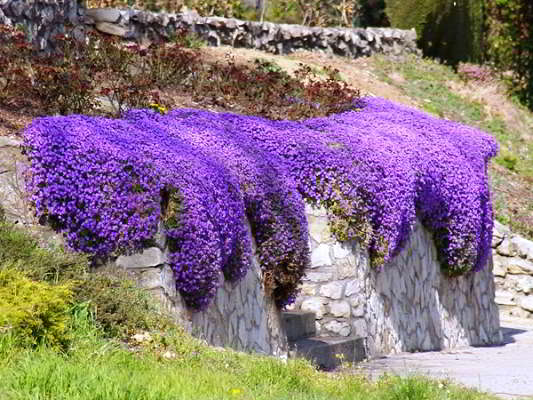
Crop care also involves a haircut. It is carried out after the end of the first wave of flowering in order to stimulate the re-establishment of peduncles. Cut off all shoots at soil level. Very soon, aubretia will again turn into a lush green pillow. And cut shoots are useful for vegetative propagation. They are rooted in perlite, maintaining a humid microclimate in the greenhouse. Plant the cuttings in a permanent location in August. Valuable varieties are reluctant to take root, it is advisable to leave them to winter in a greenhouse.
If you want to harvest seed, for growing aubriets from seeds, leave a few branches with pods before pruning. When the fruits are ripe and brown, shell the contents and store in a paper envelope at room temperature. You can immediately start podzimnuyu sowing in a flower bed.
Photo obriety
















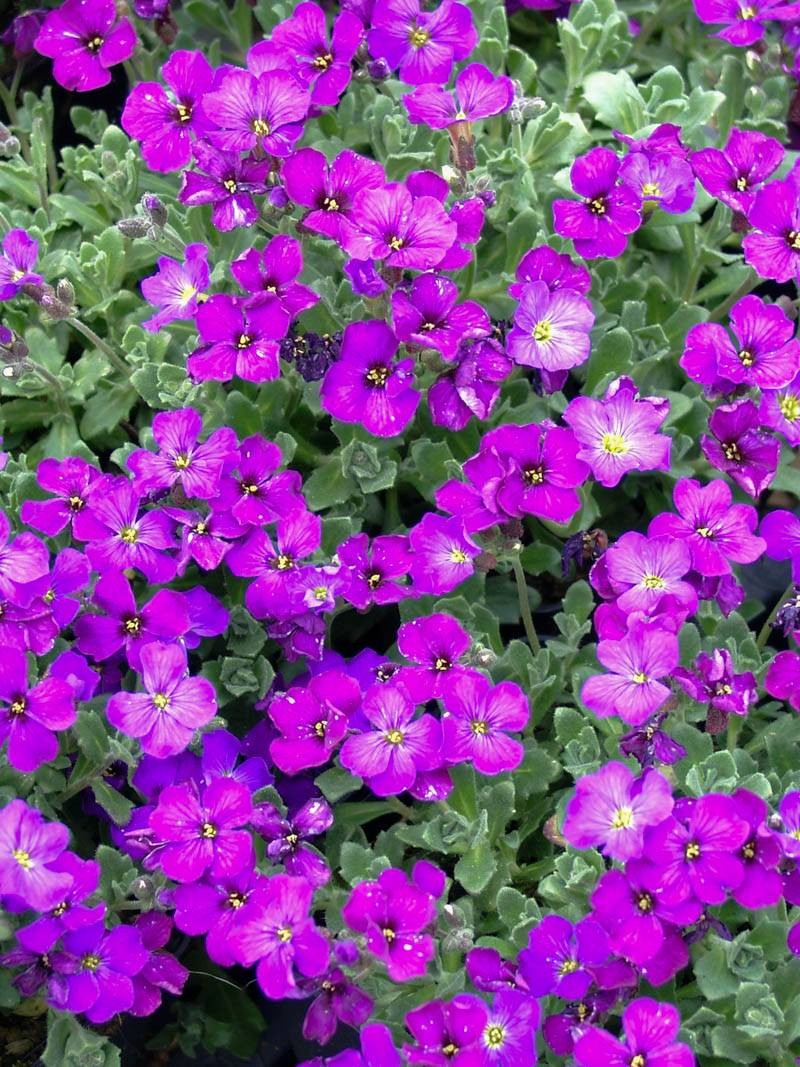








Aubrieta (aubretia) is an evergreen herb from the Cruciferous family. She adorns gardens and rock gardens throughout the European continent, but South America and Central Asia are considered to be her homeland.
Under natural conditions, the plant is most often found in rocky areas and along river banks. Lush flowering bushes cover the ground with a solid carpet, therefore, shaved, like Arabis, are planted to decorate personal plots. In addition, the plant is an excellent neighbor for other green “pets” in indoor conditions. And such a "beauty" will turn an ordinary balcony into a fabulous corner, forming a gorgeous flower cascade.
Aubrieta is similar to arabis, but the plants differ in the size of the pistils, in the latter it is much shorter and thicker. Despite its "southern" origin, aubretia is a frost-hardy plant. When winter comes, it does not shed its leaves, even the color remains the same
... In April-May, the bushes begin to bloom violently, which lasts up to 50 days. In the fall, the process of flowering is repeated at the Arietta.
The palette of shades of plant petals is quite diverse, they can be: pink, reddish, purple, blue and light blue (variety cascade blue), lilac, white, purple. Miniature leaves have an elliptical or ovoid shape, their edges can be either serrated or whole. Small flowers consist of four petals, like arabis, cluster-shaped inflorescences.
Planting aubriets in open ground
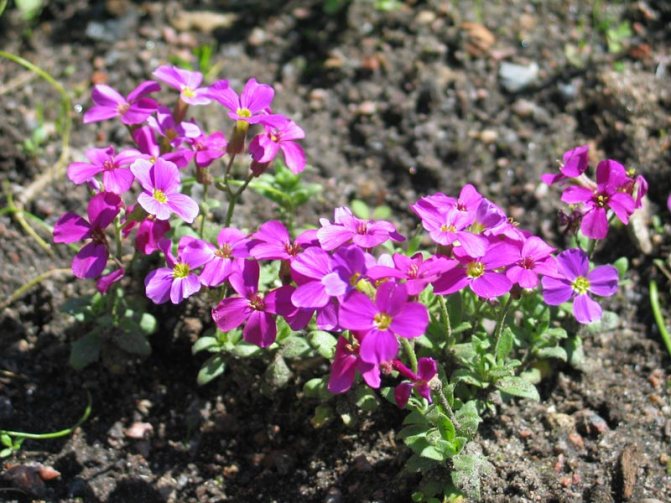
What time is the disembarkation
It is recommended to plant these flowers in open ground only after the threat of frost has passed, and as a rule, this time falls on the second half of May. For planting, choose a site carefully. When choosing a site, it should be borne in mind that for the abundant and incredibly spectacular flowering of the Aubriets, it needs the maximum possible amount of direct rays of the sun. When choosing a soil, it should be borne in mind that such flowers grow and develop the better, the poorer the soil on the site. So, this plant grows well between concrete slabs and stone steps. However, it is worth remembering that the soil needs a loose, well-permeable water, and its composition should include a small amount of peat or ash. It is also best if the soil is neutral or slightly alkaline pH 6.0-7.0.
How to plant correctly
A flower such as aubrieta is considered by gardeners to be very plastic. In this regard, it can be planted exactly as you would like, while you can create a rock garden or a flower bed of any shape. The depth of the planting hole depends on the length of the seedling roots, while its width should be 2 times the width of the pot in which the aubriet grows. When planting, it should be borne in mind that the distance between the bushes should be at least 5 centimeters. In the event that your flower grew in a container made of ceramic or plastic, then immediately before planting the pot must be completely immersed in water. Wait for air bubbles to come out of the ground
After that, carefully remove the plant along with the earthy clod and place it in the prepared hole. When the plant is planted, the soil will need to be tamped, and its surface should be sprinkled with mulch (five centimeter layer of sand), and then gently watered
Growing seedlings from seeds at home
The seedling method of growing crops is not so popular among gardeners. This is due to the slow growth of seedlings, which bloom only in the second year. When it comes to highly decorative varieties, growing seedlings is the best way to propagate a crop. When planting aubriets with seeds in the ground, the European guest is prone to changing varietal characteristics. Consider the seedling method of perennial cultivation.
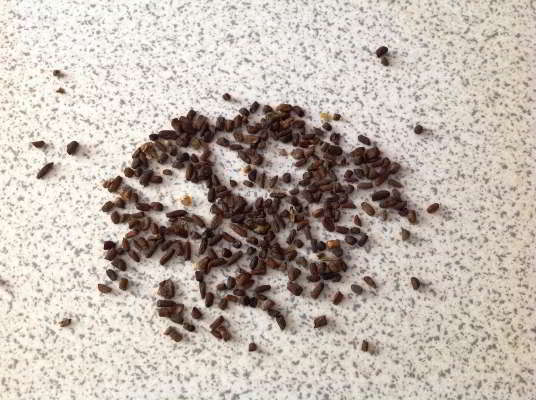
Requirements for soil and capacity for growing seedlings
The fragile root system does not tolerate damage. To save the beauty from death, seedlings are cultivated, bypassing the picking stage. Therefore, for sowing, a container is selected that allows the roots to be maximally protected from injury.For these purposes, peat tablets or cups (cassettes) made from a mixture of peat and cellulose are ideal.
The plant is not picky about the composition of the substrate. For growing from seeds, a light soil containing a small amount of lime is suitable. It is desirable that the acidity of the soil is in the range of 6-7. Cultivation of seedlings in pure vermiculite is acceptable. Do not pick up a soil mixture with a lot of fertilizer. Aubretia seedlings develop better in poor soil.
How and when to sow the seeds
Aubriet seedlings are planted in a permanent place at the age of 8-10 weeks, after the retreat of the last waves of spring frosts. During the cultivation at home, the seedlings will have time to get stronger. While some recommend sowing the seeds in late February, it is best to postpone the event until the day is long. Otherwise, you will have to use the backlight.
Important! Manufacturers do not always indicate the date of planting seeds for seedlings, since cultivation is assumed by direct sowing into the ground. The seed is planted as follows:
The seed is planted as follows:
- When using peat tablets, first prepare them by pouring warm water until the height of the cylinder increases by 5-6 times.
- If the seedlings will grow in individual cups, fill the containers with the substrate, leaving 2 cm to the top of the pot. Compact and water the soil abundantly.
- Spread 2-3 seeds evenly over the surface of the selected container.
- It is not necessary to cover the seed, cover the crops with a thin layer of sand (3 mm).
- Sprinkle sand from a spray bottle, cover the cups with foil, or place in a mini greenhouse.
- Place the seed on a well-lit windowsill or under a phytolamp; light is needed for germination. The optimum temperature for sprouting is 18-22⁰C.
Seedling care
The seedlings of aubretia sprout unevenly, the process takes 3-4 weeks. Until seedlings appear, the seedling container should be ventilated daily.
Moistening the substrate is carried out with extreme caution so as not to provoke the appearance of mold.
On a note! If the surface of the soil is covered with mold, gently remove it with a cotton swab. Sprinkle soil surface with fungicide solution.
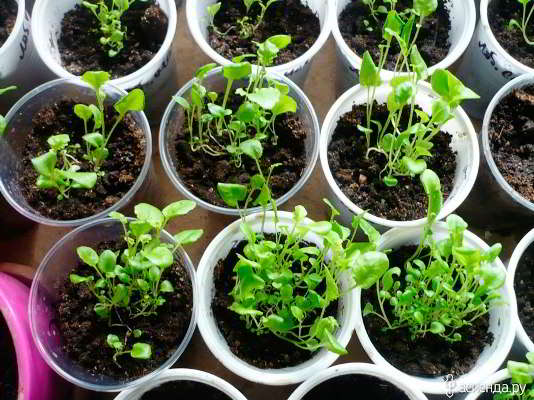
After full shoots, the shelter must be gradually removed. Further care of the seedlings consists in moderate irrigation, since the European guest is sensitive to excess moisture. Top dressing is applied 2 weeks before the intended planting on the flower bed. The full mineral complex should be added in half the concentration and only if the growth of young growth is inhibited. The cultivation of the home is completed by the procedure for hardening the seedlings in the open air. Extend the walk time gradually.
Advice
Below is a short list of tips to help you plant and grow aubrets.
- Aubrieta feels great in direct sunlight, but does not treat strong and cold winds well. Gardeners recommend planting this perennial plant near a brick wall, fence or annex that would protect the aureation from sudden gusts of wind.
- Try to regularly maintain a favorable level of humidity in the aubriet's trunk circle. This plant does not tolerate moisture stagnation, but it also cannot please you with abundant flowering in dry soil.
- Watering is carried out in the morning or in the evening to avoid exposure to wet leaves and roots of sunlight. You need to water with settled water - after watering, the soil near the bush must be loosened and cleaned of weeds. To preserve moisture for a longer period, a layer of mulch (2-3 cm) of straw, needles, bark or rotted manure is organized near the aubre.
See the next video for even more on growing aubrietta.
Growing seedlings obriety
Aubrieta propagates by seeds, and since it has a sufficiently high level of frost resistance, it can immediately be planted in open ground. However, in regions characterized by frequent spring frosts, it is recommended to first sow seeds for seedlings and only then plant the plants in the soil on the site. This method must also be used in those cases when you need to create a certain decor using obriety. 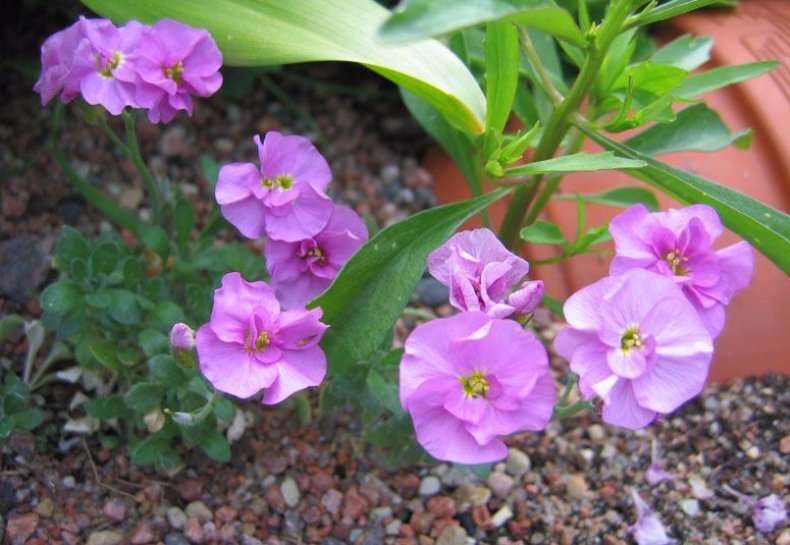
The best time to plant seeds for seedlings
Aubriet seeds for growing seedlings are best sown a couple of months before the end of the night frost. In regions with an earlier and warmer spring, this will be the beginning of February, and in areas where night frosts last longer - mid-February.
Sowing Aubrieta Seeds
For sowing seeds, you will need to prepare separate containers and soil. Peat tablets or pots are best, or regular flower pots, disposable cups. Peat containers are good in that they contribute to the development of a strong root system in the sprouts, they pass oxygen well, significantly reduce the risk of rotting of seedlings, and reduce the risks of damage to roots when transplanting plants into open ground to zero. However, such a pleasure is not cheap. 
As for the soil, a loose, well-drained sandy loam soil is most suitable for aubrietta. You can buy it in a store or make it yourself (garden soil must be mixed with peat or sand). It will also not be superfluous to add a small amount of sawdust. Clay heavy soil is categorically unsuitable for such plants.
Optimal conditions for seed germination
Aubrieta loves the sun. Therefore, it is necessary to place containers with planted seeds in a well-lit place, but avoiding direct sunlight. Plants tolerate coolness well, but the optimal temperature in the room is +18. +22 ° C. 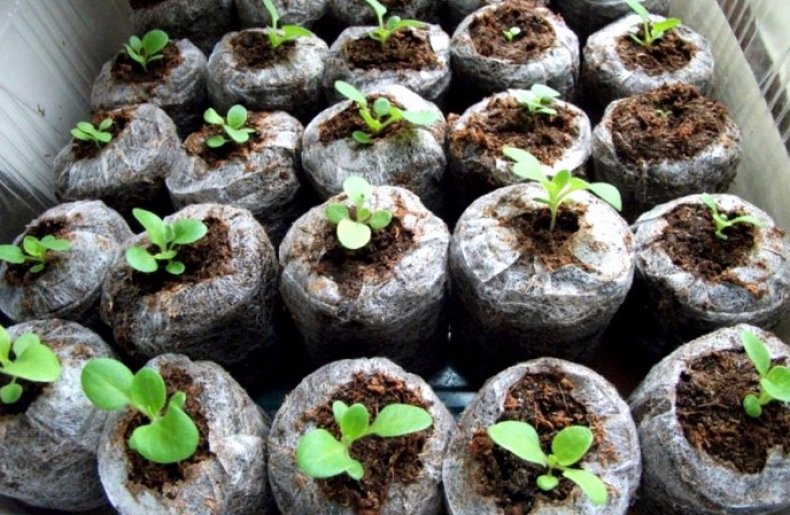
Seedling care
The most important thing in caring for seedlings is to water and loosen the soil on time. It is recommended to water with settled water at room temperature in the evening.
Make sure that a dry crust does not form on the surface, at the same time, the earth must not be flooded. If weeds appear, they must be removed immediately. The room with seedlings must be periodically ventilated.
Seedling picking
A picking involves planting sprouts in separate containers. This process is carried out to strengthen the root system and improve the nutrition of the sprouts. Aubriet picks are performed after three or four pairs of real leaves appear on the sprouts.
You need to dive the seedlings very carefully so as not to damage the delicate roots. The day before transplanting, the soil should be moistened. With the help of a pencil, the sprout is buried in, then lightly removed from the ground and immediately planted in the ground.
Aubrieta: species, popular varieties
Of the representatives of the genus Aubrieta, only two species are used in culture - cultural (hybrid) and deltoid. Deltoid aubriet is cultivated in the gardens of 1710. All modern hybrids are bred on its basis. Plants are herbaceous perennials up to 15 cm high. The flower got its name from the shape of the leaf. The triangular plates resemble the Greek letter delta.
There are 1-2 teeth along the edge of each leaflet. Due to pubescence, the plate has a gray-green color. Flowers of lilac or purple tones reach a diameter of 1 cm. They are located on ascending peduncles in the form of a loose brush. The decorative period begins in May and lasts 30-35 days.
Know! Other types of abbreviation are not widespread in Russia. But in European gardens there is a variety of Bougainvillea, Croatian, graceful, Columka.
The type of aubriet cultural includes various hybrids and varieties that differ in the color of the corolla. Plants form dense spherical bushes up to 20 cm high.The bluish foliage is perfectly preserved under the snow cover. Small spatulate blades have jagged edges. The corolla of a flower with a diameter of 10 mm is painted in a wide range of colors. The spectrum of colors includes purple, white, pink, blue, red, lilac shades.
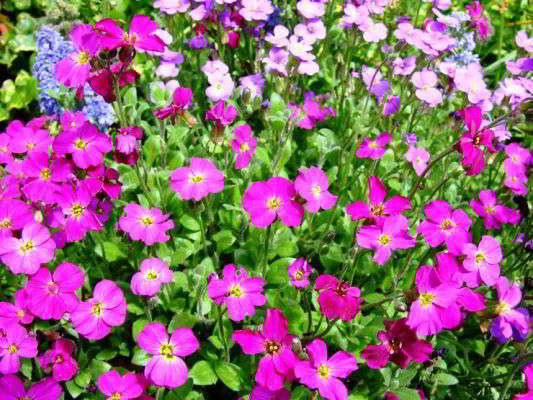
Blooming aubretia is a real waterfall (pictured), in which foliage is hidden under a dense head of flowers. Various cultivars bloom in April-May for a long time and very offensive. With proper care, the culture will delight with re-budding at the end of summer. Decorativeness lasts 5-6 weeks.
Modern hybrids differ from their predecessors in large flowers, often with double or semi-double corollas. They reproduce well by seed, but require a special approach to cultivation. There are decorative deciduous, terry, large-flowered and ampelous hybrids.
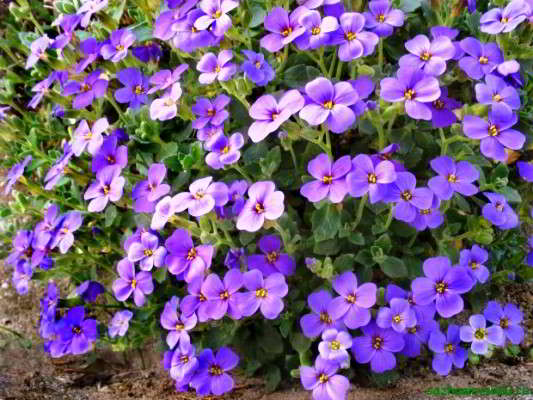
On a note! Each variety can become an exquisite decoration for sunny corners of the garden, alpine slides, rocky gardens, balcony boxes and pots. Landing in a mixborder is not recommended, since an elegant European is likely to get lost among tall neighbors.
Consider a description of the most popular abbreviation hybrids:
- Wanda - height 15-20 cm, terry flowers of light scarlet shade.
- Joy is an ampelous cultivar with a growth of 10-12 cm with strong shoots and double buds of a delicate mauve color.
- Borshiz White is a large-flowered hybrid with rare snow-white petals.
- Cascade series - ampelous cultivars of various colors. Looks spectacular in hanging pots and along the edges of the stone walls of the garden.
- Fascinating Morocco - variety mixture with bushes 8-10 cm high, densely dotted with large flowers with a diameter of 1.5 cm. A wide range of colors.
- Cote d'Azur - aubretia up to 15 cm high, with sky-blue inflorescences. Peduncles last up to two months; in the fall, repeated flowering occurs, lasting until the first frost.
- Aurea variegata is a decorative leafy form with lavender petals and leaves decorated with yellow specks.
- Argenteo variegata - white-bordered speckled leaves adorn dense curtains when bright purple flowers fade. It blooms profusely twice a season.
Remember! Hybrid varieties are very difficult to propagate by cutting and dividing the bush. Seed reproduction is a priority method of culture reproduction.
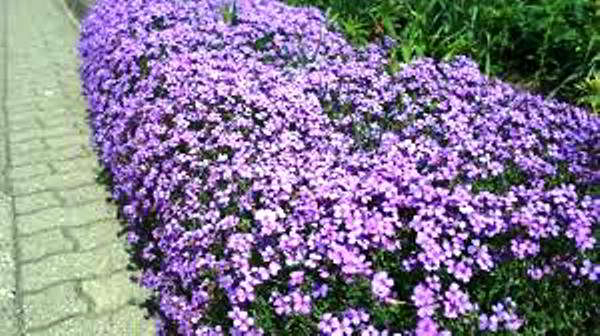
Cultivation of aobriety from seeds
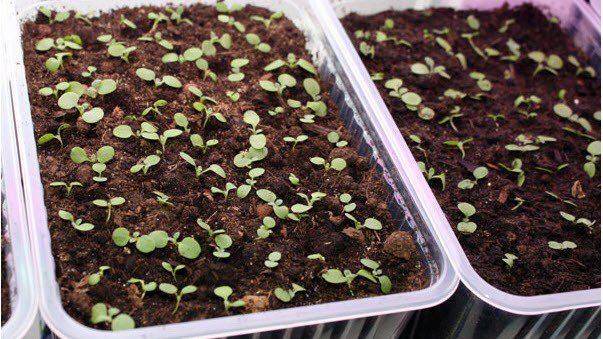
It is quite easy to propagate this plant by seeds, while it can be grown both through seedlings and in a non-seedling way. But if the sowing of seeds is carried out directly into open soil in September or May, then as a result this can lead to the splitting of varieties. In this regard, experts recommend growing aubriet exclusively through seedlings. The flowering of such a plant grown from seeds can be observed only in the second year of life. Aubriet seeds are sold in all specialty stores.
Sowing
Sowing is carried out in the last days of February, approximately 8-10 weeks before the start of heat. Seeds of such a flower are sown immediately in separate pots. To do this, you can use peat-humus pots or peat tablets, planting seedlings in open ground is carried out directly in these containers. To begin with, moisten the substrate of the pot or tablets, and then put 2 or 3 seeds on its surface. Sprinkle them on top with a thin (0.3–0.5 cm) layer of sand. Moisten the sand with a fine spray gun, and then put the containers under glass or film. The best air temperature for crops is 18-21 degrees.
How to care for seedlings

It is very easy to care for the seedlings. So, they need to arrange ventilation every day, and also water them when necessary. The first seedlings can be seen after 20-30 days, after which the shelter must be removed completely.It is necessary to water the plant very carefully, because the seedlings react extremely negatively to an excessively moist substrate. In the event that the seedlings are weak, and their development is slow, it is recommended to fertilize with a complex mineral fertilizer half a month before planting in open soil, while the concentration of the solution should be weak.
Picking
Aubrieta reacts extremely negatively to transplanting, in this regard, when growing through seedlings, picking is not performed. That is why the seeds of this plant are recommended to be sown in separate containers (for more details, see above).
2.Description - how it looks
The genus Aubrieta or aubretia includes about 12 species of evergreen plants with lodging stems.
These attractive, profusely flowering herbaceous perennials have profusely branched creeping shoots that form a continuous floral carpet.
Leaves are green, oblong - oval, sessile or on short petioles with a smooth surface or slight light pubescence. The leaf blades are entire or with small denticles along the edges. Currently, numerous variegated varieties have been bred, the edges of the leaf plates of which are decorated with stripes of yellow or white.
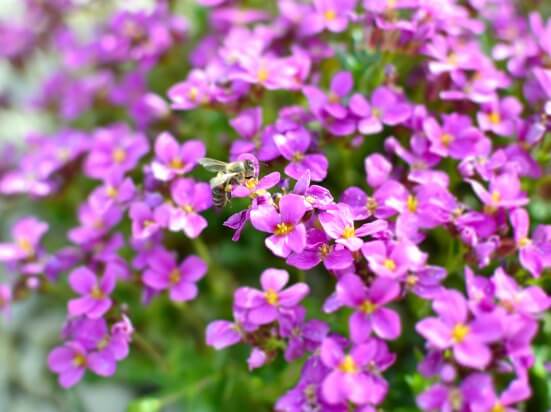
During the flowering period, the bushes form branched peduncles on the tops shoots on which numerous bright buds are located. In diameter, the buds reach only 1 cm.Modern breeders have bred numerous large-flowered varieties, the diameter of the buds of which can reach 2 cm.
Flower shades include lilac, blue, lavender, purple, white, or pink. Each flower has 4 broad petals and a center often tinged yellow or orange.
After flowering, oblong seed pods are formed - pods with small brownish seeds.

Height. Plants reach a maximum height of 15 - 20 cm - shoots spread over the surface of the soil. The length of creeping shoots can reach 30 - 60 cm.
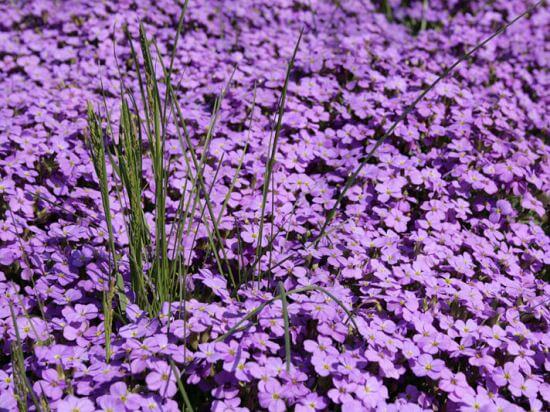
Boarding and transfer rules
Even an inexperienced gardener can handle planting aubriets - this is an extremely undemanding and simple flower when it comes to planting in open ground. Below we will consider the intricacies of planting seedlings and seeds of aubretia, as well as the features of transplanting this garden culture.
Planting seedlings in open ground
Gardeners prefer to plant aubriet seedlings in April or May, when long spring frosts have already passed. An open and well-lit place on the north side of the garden is chosen for planting.
Both fertile and depleted soil are suitable for a plant - in this sense, shaved is absolutely picky. The main condition for the type of soil is that there must be good air and water permeability, therefore ash, sand and peat are added to heavy soils with a high clay content, which allow water to be absorbed more efficiently and not linger at the roots of the plant. As for the composition of the soil, neutral or slightly acidic soils are suitable for the growth of healthy and abundant flowering.
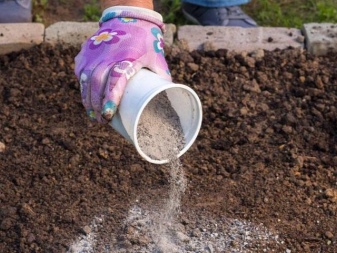
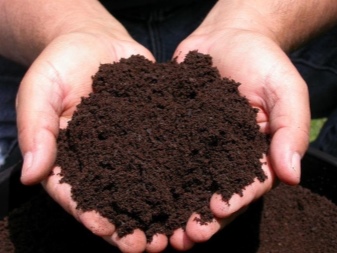
The further process of planting shaving in the garden includes several stages.
- Before planting seedlings, containers with seedlings are lowered into water. When oxygen bubbles appear on the surface of the pot, the plant is carefully pulled out and installed by transferring it into the prepared hole on the site.
- The depth of the hole should be chosen based on the age of the seedling and the size of its root system. In width, it should be slightly larger than the size of the earthen coma from the mother container.
- At the bottom of the hole, a drainage layer is organized, after which the seedling, together with an earthen clod, is installed on top of it, and the holes formed are filled with fertile soil from peat, meadow soil and sand. After filling the holes with soil, the soil in the trunk circle is compacted and watered, a layer of mulch is organized.
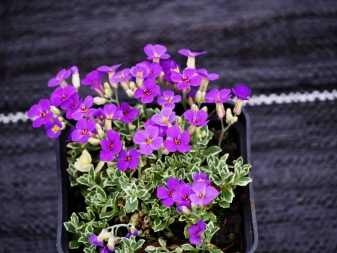

Planting seed
Experienced gardeners already prefer to plant in open ground not shaved seedlings, but seeds. Before such planting, the soil at the planting site is subjected to special treatment.
- The soil at the planting site is dug up to a depth of 15 cm, while all weeds, old roots and stones are removed from the soil.
- Top dressing is introduced into the ground in the form of lime or ash. Then the soil is carefully dug up and moistened so that the top dressing is absorbed.
- The seed is planted directly on the surface of the ground while maintaining a distance of 7-10 cm.The seeds can be pressed slightly, and then be sure to sprinkle with a layer of fine sand 3-5 cm thick.
- The area is watered abundantly with a spray bottle or watering can.
- If you planted the seeds in a warm spring and ensure regular watering, then the first shoots of the aubriet should appear in 2-3 weeks. When sowing seeds for the winter, wait for the first shoots no earlier than next spring.
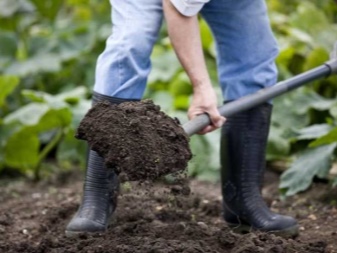

Transfer
You can transplant an Aubriet to another place in three cases:
- during reproduction by dividing the bush;
- with the growth of the maternal adult bush;
- and also in the case of buying a plant in a gardening store.
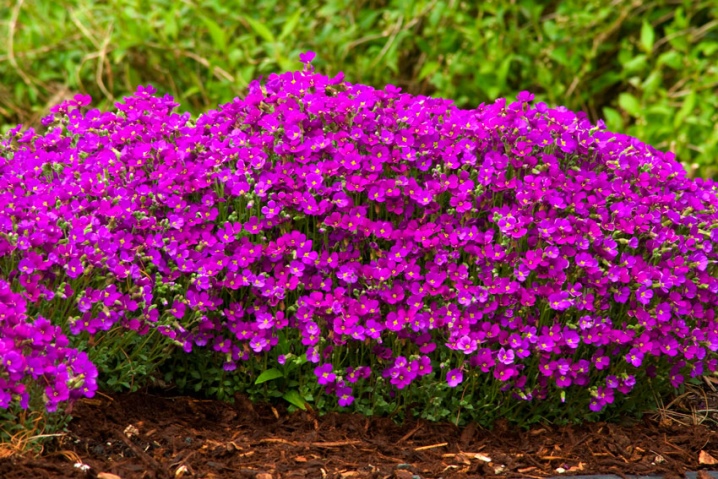
It is worth saying that the transplantation of the Ariet is not particularly good - in most cases, the transplanted plants take a long time to take root in a new hole or wither. It is for this reason that the picking of this garden plant is undesirable, and the planting of seeds for seedlings is carried out in separate pots, and not in large containers.
Usually, aubretia transplant is carried out no more than 1 time in 2 years in the case when the container with the plant ceases to contain its roots. When growing aubretia in a garden plot, this can be seen by the root shoots, which will be knocked out to the surface of the earth.
The procedure itself is carried out in the spring, before the period of active growth and flowering. In order for the plant to quickly take root in a new site, the same substrate is placed in the hole, and the temperature at the planting site must be identical to the temperature of cultivation in the previous place.
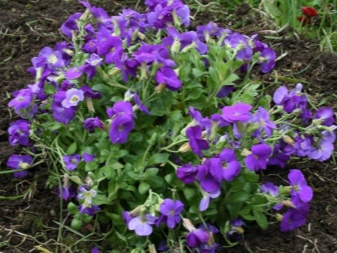
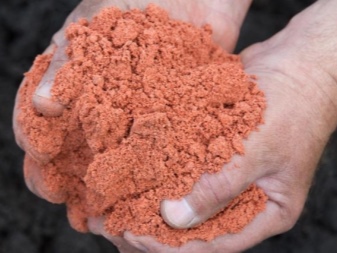
Seedling growing stages
The seedling box is placed in a sunny place, since the aubrieta is a light-loving plant. However, direct sunlight during the seedling stage should be avoided. The optimum temperature for germination of seeds and development of sprouts is from +18 to + 21 ° C. It is desirable to additionally illuminate with a lamp in the evening hours.
Periodically, the room with seedlings needs to be ventilated. It is not necessary to expose the box to a draft; it is enough to slightly lower the temperature of the air for hardening.
Seedlings are regularly watered in the evenings with warm, settled water as the top layer of the soil dries up. A dry crust must not be allowed to form.
The picking is done about a month after sowing, from the moment 3-4 pairs of true leaves appear. The day before transplanting into a new container, the soil is abundantly moistened. The sprout is transferred to new dishes by transferring. It is poured in with a teaspoon, carefully removed and immediately placed in new soil.
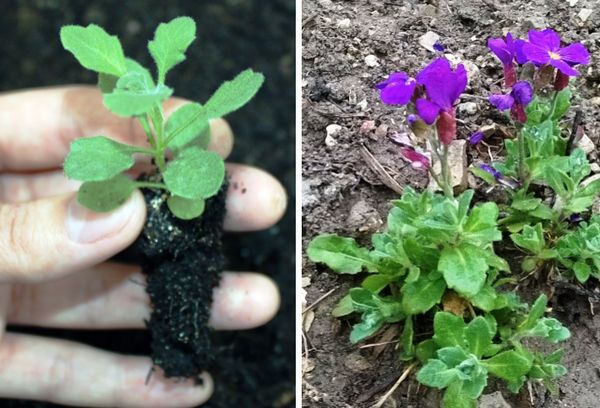
Transplantation to the site takes place at the end of April - mid-May, by which time the soil should warm up enough.
Adult shave care:
- To maintain flowering, you need to fertilize the obrieta with a mineral complex (nitrogen, phosphorus and potassium) every 10 days. Aubriet growing on fertile soils is enough 3 dressings within 2 months. Potassium humate is added between the main dressings, but not more often than twice a month.
- Every month the soil around the bush is loosened.
- All weeds are removed as needed.
- The soil is mulched with sand and sawdust on average once every 10 days. This will prevent rotting.
- Frequent watering is not required, but in dry times, you will need to moisten the soil twice a week.
Aubrieta bloom begins in May-June and lasts for about 1.5 months. There is a way to prolong it: after the first stage, cut off the faded shoots under the root, this stimulates the emergence of new flowering shoots.It is recommended to moisten, fertilize and mulch the soil to support the plant. This is how gardeners maintain their flower cover throughout the summer.
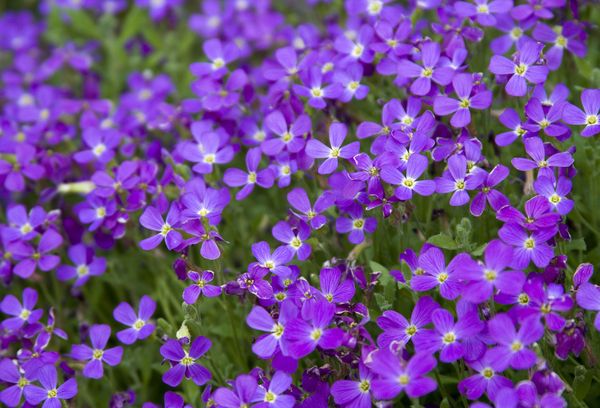
Autumn pruning is not carried out as it weakens the plant. To preserve the shaving for the next season, it is enough to cover its roots: a heap of dry leaves will do. Aubrieta does not shed its leaves during the winter and remains green. Only sharp frosts down to –30 ° C can harm it.
Use in landscape design
Aubriet flowers attract attention with their bright petals. A wonderful effect is obtained when planting a plant in higher elevations.
You can create a cascade of hanging shoots of shaved by decorating a fence with it. Lush flowering can be achieved if you follow the rules of planting and care. The photo of a perennial obriety, presented below, demonstrates how this plant can decorate a personal plot.
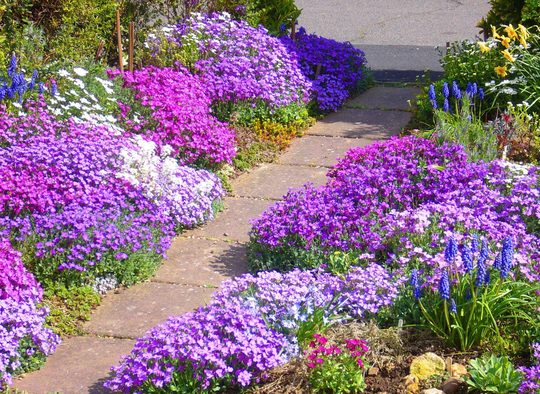
If you mix seeds of several varieties, you can get unusually beautiful combinations in which flowers of various shades will be present.
Aubrieta goes well with other ornamental plants: razuh Caucasian, alissum, red soapwort, irises, milkweed.
This delightful integumentary plant begins to delight in its beauty as other flowers are just about to form buds. Aubrieta is used to decorate garden paths and ladders. It is great for a rock garden.

Aubrieta is used in vertical and horizontal decoration of landscape design elements. The photo above shows one of the options for vertical landscaping with natural plant growth.
Flower characteristic
Aubrieta is an evergreen, creeping plant of the cabbage family. Its natural habitats are the shores and rocky areas of South America, and the Aubriet is also found in Asia Minor. The plant itself is very beautiful. If you sow it relatively thickly, you get a “flower carpet”. Above are especially popular:
- purple;
- red;
- pink;
- white.
The flowers of this plant are small, but they are "long-livers". Before planting an obrieta, you need to choose the most lighted garden for it.
It is important to consider such features.
- Aubrieta requires a sufficient amount of sunlight.
- The plant needs soil that retains moisture for a long time. The acidity of the soil is very important: it should be neutral or low, in the pH range from 6 to 7.
- Aubriet needs to be weeded. The weed should not interfere with the growth of the flower.
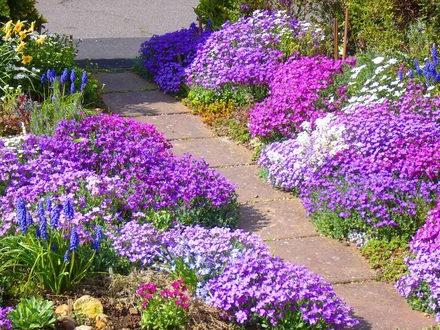
In terms of soil nutritional value, the plant is not absolutely demanding. Aubrieta grows well in poor soil, but it is still better to enrich its composition by adding peat and charcoal. This will accelerate the growth of the shaved woman, help her to reveal her beauty to the fullest.

